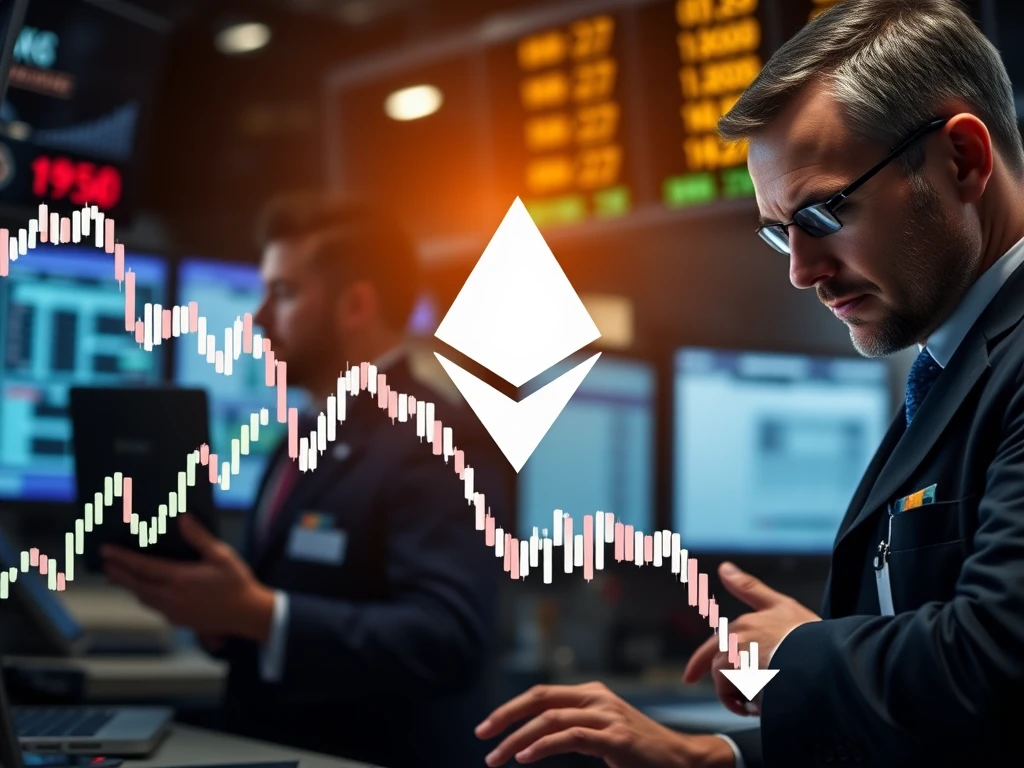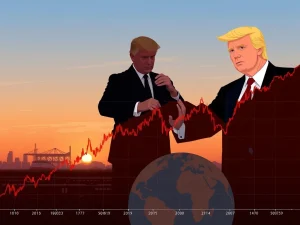Critical Low: Ethereum Futures Premium Plunges to 1-Year – Buy ETH Bottom?

Is the crypto market flashing a major buy signal for Ethereum? Recent market turbulence has sent Ether (ETH) prices tumbling, dipping by 9.3% between March 26th and 28th and briefly testing the $1,860 mark. This price correction wasn’t just a minor tremor; it triggered over $114 million in liquidations in leveraged ETH futures. But here’s the intriguing part: the premium on ETH futures contracts has plummeted to a level not seen in over a year. Some analysts are interpreting this rock-bottom Ethereum futures premium as a definitive sign of an impending market bottom, suggesting it might be the perfect moment to scoop up ETH. But is this optimism justified? Let’s delve deeper into the data and dissect whether this futures dip truly signals a golden buying opportunity or a potential value trap.
Ethereum Futures Premium Plummets to 1-Year Low: Decoding the Signal
To understand the significance of the current situation, it’s crucial to grasp what the Ethereum futures premium represents. In essence, the futures premium is the difference between the price of a futures contract and the spot price of the underlying asset – in this case, Ether. Futures contracts, especially monthly ones, typically trade at a premium because sellers demand compensation for the time value and potential risks associated with a longer settlement period. A healthy, neutral market usually exhibits an annualized premium of 5% to 10%, reflecting opportunity costs and exchange risks.
However, the landscape shifted dramatically for ETH futures. Following a significant 24% price correction in the two weeks leading up to March 8th, the Ethereum futures premium dipped below this neutral threshold. Currently, it hovers around a mere 2% annualized premium. This low figure suggests a weakened appetite for leveraged long positions (bets that the price will rise). But context is key. These premiums are highly sensitive to recent price swings. For instance, back on October 10, 2024, after a sharp 14% price correction in just two weeks, the ETH futures premium also touched a low of 2.6%. Interestingly, as ETH subsequently recovered most of its losses, this premium rebounded to 7%. Historically, the futures premium hasn’t consistently acted as a reliable predictor of spot price trend reversals. Therefore, while a low premium might seem like a buy signal, it’s essential to look at other indicators for confirmation.
Is This a False Alarm or a Real Buy Signal for ETH Bottom? Analyzing Whale Sentiment
To gain a clearer picture of whether we are truly at an ETH bottom, we need to gauge the sentiment of larger market participants, often referred to as ‘whales.’ A crucial tool for this is examining the options market, specifically the 25% delta skew. This metric compares the pricing of put (sell) options versus call (buy) options. When traders anticipate further price declines, demand for put options (for hedging against downside risk) increases, pushing the 25% delta skew above 6%. Conversely, during bullish phases, the skew tends to fall below -6% as call options become more attractive.
Currently, the 25% delta skew for ETH options stands at 7%. This elevated level indicates that professional traders are exhibiting a lack of bullish conviction and are leaning towards hedging against potential further price drops. This bearish sentiment among sophisticated traders casts doubt on the notion that the recent correction has definitively reached an ETH bottom. The derivatives market data suggests that investors are not yet convinced that the $1,800 support level will hold firm, implying a higher probability of continued bearish momentum.
Layer-2 Scalability and Network Activity: Are They Weakening ETH’s Appeal?
Beyond derivatives market indicators, fundamental factors might be contributing to the reduced appeal of ETH and influencing the current price action. Some analysts point to a noticeable decline in network activity on the Ethereum blockchain as a primary concern. Others highlight the successful shift towards layer-2 scalability solutions, which, while beneficial for overall Ethereum ecosystem growth, may have inadvertently diminished the potential for high base chain fees. Ethereum’s economic model relies on transaction fees to compensate network validators. If capital inflow slows down and base layer fees decrease, it necessitates increased ETH issuance to maintain validator rewards, which can negatively impact the net returns from native staking and potentially exert downward pressure on the ETH price.
Furthermore, Ethereum faces intensifying competition from other blockchain networks. The competitive landscape has expanded beyond established players like BNB Chain and Solana to include specialized networks tailored for specific niches. Examples include Hyperliquid, focusing on synthetic assets and perpetual trading, and Berachain, designed for staked assets in cross-liquidity pools. The emergence and success of decentralized applications (DApps) on competing chains could further erode Ethereum’s dominance. The recent example of Ethena, a prominent synthetic dollar protocol on Ethereum with $5.3 billion in total value locked (TVL), transitioning to its own layer-1 blockchain underscores this competitive pressure. Ethena raised $100 million in December 2024 to facilitate this migration, signaling a potential shift in DApp ecosystems.
Pectra Upgrade: A Potential Catalyst for Ethereum’s Revival?
However, it might be premature to definitively conclude that the ETH price will continue its downward trajectory. A significant development on the horizon is the upcoming Ethereum Pectra upgrade, expected within weeks. This upgrade could introduce crucial improvements to base layer fees and overall usability for the average user. Investors should closely monitor the practical benefits and impacts of the Pectra upgrade. If it successfully addresses concerns around network activity and usability, it could reignite interest in Ethereum and potentially trigger a price recovery. Until the tangible benefits of the Pectra upgrade become apparent, the likelihood of ETH significantly outperforming the broader altcoin market may remain limited.
In Conclusion: Proceed with Caution, Monitor Pectra
The current low Ethereum futures premium, while seemingly a bullish indicator to some, is not a definitive buy signal in isolation. Bearish sentiment in the options market, coupled with concerns about network activity and increasing competition, suggests that the path to an ETH bottom might still be uncertain. However, the upcoming Pectra upgrade represents a potential turning point. Investors should remain vigilant, track the progress and impact of the Pectra upgrade, and conduct thorough research before making any investment decisions. The market remains volatile, and while opportunities may arise, caution and informed decision-making are paramount.
Disclaimer: This article is for general information purposes only and does not constitute legal or investment advice. The views expressed are solely the author’s and do not represent the views of Crypto News Insights.
#Cryptocurrencies #Ethereum #DApps #Markets #Leverage #Futures #Market Analysis #Ethereum Options #Solana








